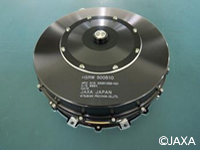Reaction Wheel Assenmbly Type S

| Registration date | 5/15/2014 |
|---|---|
| JAXA development group | Research Unit I, Research and Development Directorate |
| View diagram | See Attachment 1 |
| Environmental resistance | See Attachment 2 |
| Patent number (publication number) |
N/A |
| Reference | N/A |
| Satellite and launch date | Flight models will be launched on Super Low Attitude Test Satellite (SLATS) in FY2016 |
| Note | N/A |
Manufacturer
Mitsubishi Precision Company, Limited
Kamakura-shi, Kanagawa, Japan
https://www.mpcnet.co.jp/e/index.html
Features
Type S is a part of the new reliable low-disturbance reaction wheel assembly family (Type L, Type M and Type S).
Type S exploits the heritage of the advanced and highly-reliable design of its predecessors, Types L and M, but is optimized for its small-size,
light-weight and low-cost requirements for small spacecraft missions.
Applications
Reaction Wheel is a attitude control actuator for 3-axis stabilization of spacecraft.
Type S covers a storage momentum range from 5 Nms upto 10 Nms for spacecraft weight between 300 kg and 500 kg.
Specifications
| Item | Specification | |
|---|---|---|
| Momentum (Max.) | 5 Nms, 10 Nms (2 version) | |
| Output torque (Max.) @5000 rpm | >0.06 Nm | |
| Speed range | -5000 to 5000 rpm | |
| Run-up time 0 to 5000 rpm @output torque (Max.) |
5 Nms : <83 s 10 Nms : <167 s |
|
| Coast-down time 5000 to 100 rpm @motor off |
5 Nms : >327 s 10 Nms : >653 s |
|
| Power consumption | Peak torque @5000 rpm, 0.06 Nm |
<69 W |
| Steady state @5000 rpm, 0 Nm |
<15 W | |
| Disturbance force / torque | force | <2 × 10-4 × f2 N @10 ≦ f ≦ 83.3 Hz <1.4 N @f >83.3 Hz |
| torque | <4 × 10-5 × f2 Nm @10 ≦ f ≦ 83.3 Hz <0.28 Nm @f >83.3Hz |
|
| Bus voltage | 22 to 52 Vdc | |
| Vibration | sine wave | 245.2 m/s2 (25 G) |
| random | 196.0 m/s2 r.m.s. (in-plane) 206.3 m/s2 r.m.s. (outo-of-plane) |
|
| Temperature range | Operation | -15 to +60 °C |
| Turn-on | -30 to +60 °C | |
| Non-operation (storage) | -30 to +70 °C | |
| Life | On round and storage | >5 years |
| On orbit | >10 years | |


